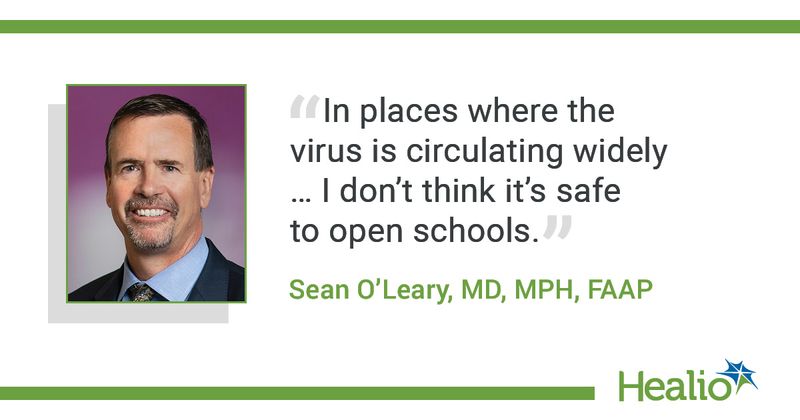Q&A: Pediatric COVID-19 cases increase by 90% over 4 weeks
According to a new AAP report, there were 179,990 new pediatric cases of COVID-19 between July 9 and Aug. 6 in the United States — a 90% increase over 4 weeks.
In a news release, the AAP urged pediatricians to “emphasize the need for communities to lower virus numbers before reopening schools” for in-person attendance.


“In areas with rapid community spread, it’s likely that more children will also be infected, and these data show that,” AAP President Sally Goza, MD, FAAP, said in a statement. “As a pediatrician, I urge people to wear cloth face coverings and be diligent in social distancing and handwashing. It is up to us to make the difference, community by community.”
Healio spoke with Sean O’Leary, MD, MPH, FAAP, vice chair of the AAP’s Committee on Infectious Diseases, about the increase in cases and what it means.
Question: What caused the 90% increase in cases?
Answer: I think the biggest contributor is just the overall increase in cases in many parts of the country. When the general population is seeing more infections, we're going to see more infections in children for sure.
Q: What else do the data show?
A: I think there are a few things that are in the data. One is that, yes, it does continue to appear that children are less severely affected than older adults in terms of hospitalization rates and deaths. But it's also important to note that by no means is COVID-19 a completely benign illness in children.
We've had already 90 deaths reported from COVID-19 in the short time since this pandemic began, with a relatively small proportion of the overall population having been exposed to the virus at this point. So, the data confirm, to an extent, what we already knew about severity in children, but they also point out that it's not completely benign.
Q: What unanswered questions remain?
A: I think there are many things that we need to better understand about infections in children. It's still being worked out how likely children are to get infected compared with adults, and how likely they are to spread the infection. We're learning more about that all the time.
The other thing that we would be great is if we had more uniform data within the U.S. so that we're comparing apples to apples. States are tracking their data in different ways. As you [see] from the report, some states have much more complete data than others. So, that's one issue.
Another issue is it would be better to understand the racial and ethnic disparities as they impact children. There have been some reports on that, and it seems to be parallel to what we're seeing in adults, with communities of color being more disproportionately impacted, but many of the states don't report race and ethnicity.
Q: What can pediatricians do with the data in the report?
A: Pediatricians are already well aware that kids can get infected, and I think this information can help them in their counseling and families. There are still people who aren't particularly worried about this virus, and we all should be worried about this virus to protect the most vulnerable among us but also our children.
Q: Does the increase mean that schools should remain closed.
A: That’s the million-dollar question. We've been saying all along that we, of course, very much favor — along with the other education groups — that children be physically present in school. But that has to be done in a manner that's safe for students, teachers and staff.
In places where the virus is circulating widely, as it is in much of the country, I don't think it’s safe to open schools in those settings for two main reasons. One, if it's circulating widely in the community, it's also going to circulate in the schools. It's inevitable, and so that puts students and teachers at risk, as well as the staff in the schools, the bus drivers and so on. Because there's so much circulating in the community, it will be impossible to keep it out of the schools, even with mitigation measures in place, and you're already seeing evidence of that with some of the schools that tried to open — for example, in Georgia.
The second big issue is, just practically, it doesn't make sense. Even if they have the perfect mitigation strategy in place and there's no transmission within the school — which is impossible, but you could do the best possible job — it will come in from other places, and they'll identify cases within the schools. Whether it's teachers or students who have it, all public health agencies — local and state public health — have a number that they use to decide when they will close a school. If you have a lot circulating the community, immediately you're going to see some of the schools abruptly shut down.
That's why in many parts of the U.S., I don't think right now is the time [to open]. There are some places, though, that have reason for optimism. A lot of the states in the Northeast have done a very good job, at this point, in controlling the virus. I think there's reason for optimism in some of those states. I’m in Colorado, and we're sort of right on that edge where we'd all like to see it a little bit lower than where it is right now before we say, “Let’s open them all.”
References:
- AAP. American Academy of Pediatrics tracking children’s COVID-19 cases by state, reflecting increasing cases. https://services.aap.org/en/news-room/news-releases/aap/2020/american-academy-of-pediatrics-tracks-childrens-covid-19-cases-by-state-reflecting-increasing-cases/. Accessed August 12, 2020.
- AAP. Children and COVID-19: state-level data report. https://services.aap.org/en/pages/2019-novel-coronavirus-covid-19-infections/children-and-covid-19-state-level-data-report/. Accessed August 12, 2020.

